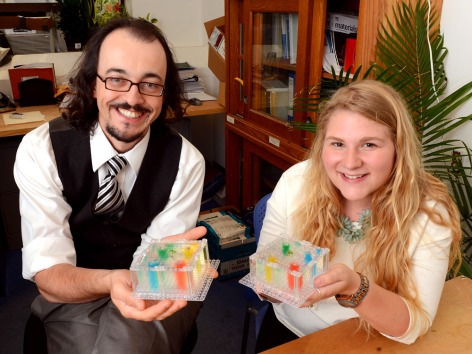Ames, Iowa, USA
June 26, 2014

Iowa State's Ludovico Cademartiri and Kara Lind have used LEGO bricks to build engineered environments to study environmental impacts on plants. The colors inside the LEGO structures show various plant nutrients. Larger photo. Photo by Bob Elbert
Ludovico Cademartiri had what seemed like an impossibly demanding list of requirements for his lab equipment.
The Iowa State University assistant professor of materials science and engineering wants to understand environmental effects on plant growth, specifically how variations in climate and soil characteristics affect root growth. That requires highly controlled environments that expose whole plants to environmental effects such as nutrients, water, oxygen gradients as well as physical obstacles for the roots.
Greenhouses can create fairly controlled environments for whole plants, but they’re homogeneous. And microfluidic technologies can create highly controlled micron-scale environments, but they’re expensive, relatively complex and not easy to scale up.
Cademartiri was looking for a way to study plant and root growth that was simple, inexpensive and flexible, something that allowed experiments to be reproduced all over the world, even in labs without the latest technologies or the infrastructure required for plant science or agronomy research. He was looking for something modular, scalable and structurally precise. He wanted something simple, reproducible, affordable and capable of many simultaneous experiments. He was looking for something transparent, autoclavable, three-dimensional, chemically inert and compatible with existing plant growth experiments.
And he thought of the perfect something from the toy aisle: LEGO bricks.
“Forget for a minute that they’re used as toys,” Cademartiri said. “They’re actually pieces of high-quality plastic, built to extraordinary standards of precision, that you can use to build stuff.”
They’re also “a good example of how something simple can solve a complex design problem,” he said.
Cademartiri and his research group report their use of LEGO bricks to successfully build engineered environments for plant and root studies in a paper just published by the peer-reviewed, online journal PLOS ONE.
The paper’s authors include Cademartiri; Kara Lind, an Iowa State doctoral student in materials science and engineering; Saida Benomar, a former postdoctoral research associate at Iowa State and the U.S. Department of Energy’s Ames Laboratory; Anthony Miller, a former Iowa State undergraduate in agronomy; and Tom Sizmur, a former postdoctoral research associate at Iowa State and the Ames Lab, now of Rothamsted Research in Harpenden, England.
Lind said her primary role with the project was figuring out how to configure transparent LEGO bricks to hold gel or other soil substitutes for germinating and growing plants. She also experimented with ways to make the LEGO environments bigger to accommodate growing plants. And she developed techniques to create controlled chemical gradients in the LEGO environments with the intent of testing plant response to nutrients and toxins.
“When I started this research program, there was a lack of tools for the creation of highly controlled and yet frugal environments capable of holding an entire plant,” Cademartiri said. “The first objective we focused on was building a library of tools that would be accessible to everybody and allow them – and us – to proceed to scientific experiments.”
The researchers accomplished their objective: “We here demonstrate that LEGO bricks are highly convenient and versatile building blocks for building centimeter-scale engineered environments for plant roots,” they wrote in their paper.
Will the paper have other researchers visiting the toy aisle or placing orders at lego.com?
“We do believe it could be useful,” Cademartiri said.
The researchers wrote in their paper that they’ll continue to develop this library of tools for “the fabrication of frugal but sophisticated” environments for studies of plants and other organisms.